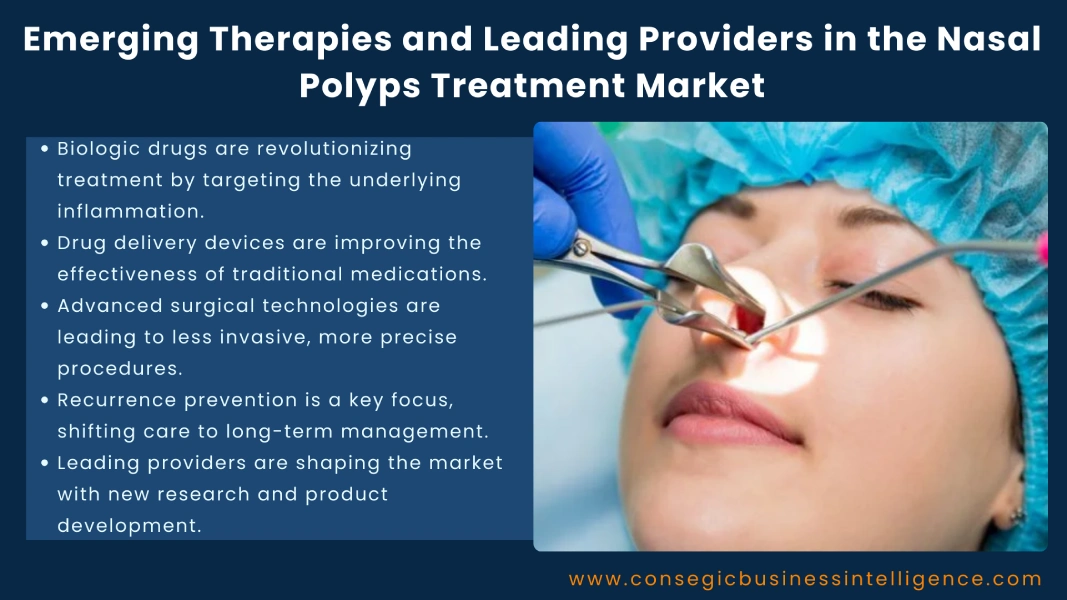Emerging Therapies and Leading Providers in the Nasal Polyps Treatment Market
Nasal polyps, often linked with chronic rhinosinusitis, are soft, noncancerous growths in the nasal passages or sinuses that cause congestion, loss of smell, and breathing difficulties. While surgery and corticosteroids have been the traditional treatment approaches, recurrence rates are high, creating a need for long-term and more targeted solutions. In recent years, the nasal polyps treatment market has been witnessing rapid innovation, with biologic drugs, advanced drug delivery devices, and improved surgical technologies entering clinical practice. Leading pharmaceutical and medical device companies are driving these advancements, making the market increasingly dynamic and patient-focused.

Below are the key emerging therapies and the providers leading this transformation.
- Dupixent by Regeneron and Sanofi
Dupixent (dupilumab) is the first biologic therapy approved specifically for chronic rhinosinusitis with nasal polyps (CRSwNP). It works by blocking the IL-4 and IL-13 pathways, reducing type-2 inflammation and significantly lowering polyp size, congestion, and the need for surgery. Regeneron and Sanofi’s strong global presence and ongoing clinical programs have made Dupixent a cornerstone treatment and a leading driver of growth in this market.
- Xolair by Novartis and Genentech
Xolair (omalizumab), an anti-IgE monoclonal antibody, has expanded its indication to include patients with nasal polyps. This therapy offers targeted relief for those with allergic or eosinophilic disease profiles. Novartis and Genentech, with their established expertise in biologics, are ensuring Xolair’s adoption across key markets, making it an important alternative for patients who do not respond adequately to corticosteroids or surgery.
- Nucala by GlaxoSmithKline
GSK’s Nucala (mepolizumab) targets IL-5 to reduce eosinophilic inflammation, a key driver of nasal polyp growth. It has proven effective in lowering the need for oral corticosteroids and reducing recurrence rates after surgery. GSK’s commitment to respiratory and immunology research has positioned Nucala as a valuable therapy for severe cases, strengthening the company’s role in expanding biologic options for nasal polyp patients.
- Tezepelumab by AstraZeneca and Amgen
Tezepelumab, an investigational biologic targeting TSLP (thymic stromal lymphopoietin), represents the next wave of innovation. Early studies show strong efficacy in reducing polyp burden and improving quality of life. AstraZeneca and Amgen’s continued investment in clinical development signals their commitment to broadening therapeutic choices in CRSwNP, particularly for patients unresponsive to existing biologics.
- Medtronic’s Steroid-Eluting Implants
Medtronic, through its acquisition of Intersect ENT, offers steroid-eluting sinus implants such as PROPEL and SINUVA. These devices provide localized, sustained drug delivery directly into the sinuses, helping reduce inflammation and prevent recurrence after surgery. Medtronic’s leadership in medical devices and ENT solutions ensures these implants remain integral to both post-surgical management and non-surgical treatment strategies.
- Optinose and the XHANCE Delivery System
Optinose has introduced the XHANCE nasal spray, which uses an innovative exhalation delivery system to deposit medication deeper into the sinuses. This improves drug effectiveness compared to conventional sprays, particularly in hard-to-reach areas. Optinose’s technology highlights the growing importance of drug delivery innovation in the nasal polyps market, offering patients a non-surgical option with enhanced outcomes.
- Surgical Solutions from Olympus and Stryker
When medical management fails, endoscopic sinus surgery remains a critical intervention. Companies like Olympus and Stryker provide advanced surgical instruments, navigation systems, and imaging technologies that improve surgical precision and reduce recurrence. Their continuous improvements in minimally invasive techniques ensure that surgery remains safer and more effective, complementing the rise of biologics and implants.
- Emerging Digital and Supportive Care Providers
Beyond drugs and devices, digital health tools and support programs are also becoming part of the treatment ecosystem. Providers are developing patient monitoring platforms, mobile apps, and education programs that help improve adherence to biologics or topical therapies. These supportive care solutions enhance treatment outcomes and reduce relapse risk, highlighting how holistic care is shaping the nasal polyps treatment landscape.
Conclusion
The nasal polyps treatment market is undergoing a major transformation as biologic therapies, advanced implants, innovative delivery systems, and surgical technologies converge to improve patient outcomes. Companies like Regeneron, Sanofi, Novartis, GSK, AstraZeneca, Amgen, Medtronic, Optinose, Olympus, and Stryker are at the forefront of this revolution. With continued investment in research and patient-centered solutions, the future of this market promises greater choice, fewer relapses, and improved quality of life for millions of patients worldwide.
